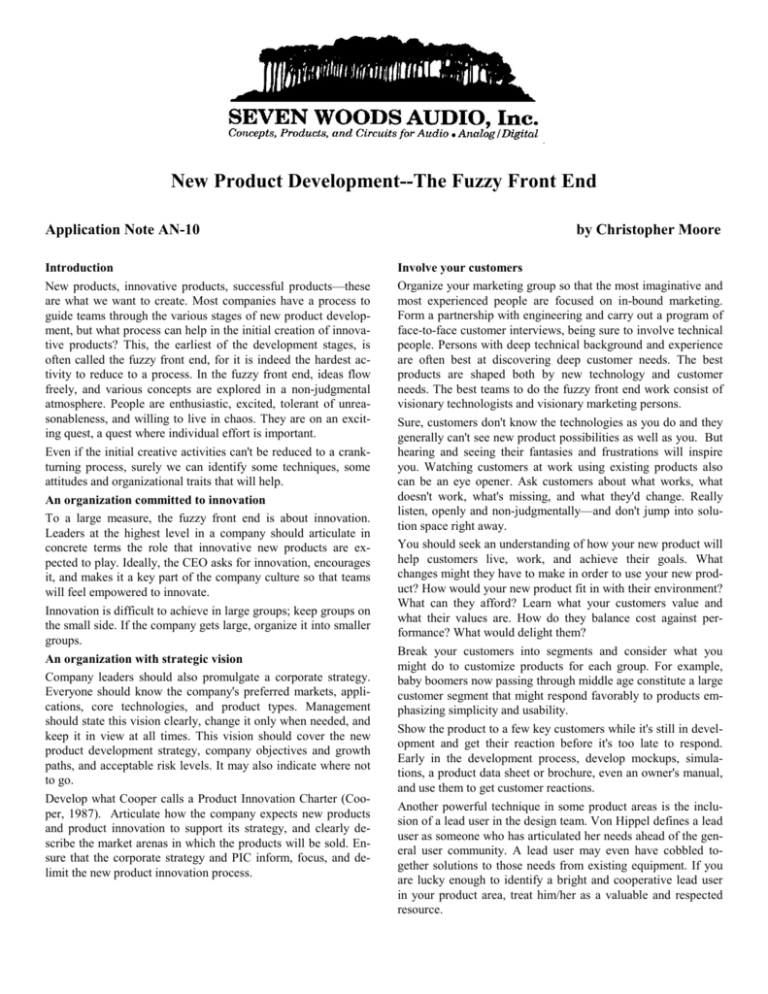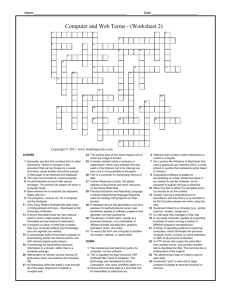
New Product Development--The Fuzzy Front End
Application Note AN-10
Introduction
New products, innovative products, successful products—these
are what we want to create. Most companies have a process to
guide teams through the various stages of new product development, but what process can help in the initial creation of innovative products? This, the earliest of the development stages, is
often called the fuzzy front end, for it is indeed the hardest activity to reduce to a process. In the fuzzy front end, ideas flow
freely, and various concepts are explored in a non-judgmental
atmosphere. People are enthusiastic, excited, tolerant of unreasonableness, and willing to live in chaos. They are on an exciting quest, a quest where individual effort is important.
Even if the initial creative activities can't be reduced to a crankturning process, surely we can identify some techniques, some
attitudes and organizational traits that will help.
An organization committed to innovation
To a large measure, the fuzzy front end is about innovation.
Leaders at the highest level in a company should articulate in
concrete terms the role that innovative new products are expected to play. Ideally, the CEO asks for innovation, encourages
it, and makes it a key part of the company culture so that teams
will feel empowered to innovate.
Innovation is difficult to achieve in large groups; keep groups on
the small side. If the company gets large, organize it into smaller
groups.
An organization with strategic vision
Company leaders should also promulgate a corporate strategy.
Everyone should know the company's preferred markets, applications, core technologies, and product types. Management
should state this vision clearly, change it only when needed, and
keep it in view at all times. This vision should cover the new
product development strategy, company objectives and growth
paths, and acceptable risk levels. It may also indicate where not
to go.
Develop what Cooper calls a Product Innovation Charter (Cooper, 1987). Articulate how the company expects new products
and product innovation to support its strategy, and clearly describe the market arenas in which the products will be sold. Ensure that the corporate strategy and PIC inform, focus, and delimit the new product innovation process.
by Christopher Moore
Involve your customers
Organize your marketing group so that the most imaginative and
most experienced people are focused on in-bound marketing.
Form a partnership with engineering and carry out a program of
face-to-face customer interviews, being sure to involve technical
people. Persons with deep technical background and experience
are often best at discovering deep customer needs. The best
products are shaped both by new technology and customer
needs. The best teams to do the fuzzy front end work consist of
visionary technologists and visionary marketing persons.
Sure, customers don't know the technologies as you do and they
generally can't see new product possibilities as well as you. But
hearing and seeing their fantasies and frustrations will inspire
you. Watching customers at work using existing products also
can be an eye opener. Ask customers about what works, what
doesn't work, what's missing, and what they'd change. Really
listen, openly and non-judgmentally—and don't jump into solution space right away.
You should seek an understanding of how your new product will
help customers live, work, and achieve their goals. What
changes might they have to make in order to use your new product? How would your new product fit in with their environment?
What can they afford? Learn what your customers value and
what their values are. How do they balance cost against performance? What would delight them?
Break your customers into segments and consider what you
might do to customize products for each group. For example,
baby boomers now passing through middle age constitute a large
customer segment that might respond favorably to products emphasizing simplicity and usability.
Show the product to a few key customers while it's still in development and get their reaction before it's too late to respond.
Early in the development process, develop mockups, simulations, a product data sheet or brochure, even an owner's manual,
and use them to get customer reactions.
Another powerful technique in some product areas is the inclusion of a lead user in the design team. Von Hippel defines a lead
user as someone who has articulated her needs ahead of the general user community. A lead user may even have cobbled together solutions to those needs from existing equipment. If you
are lucky enough to identify a bright and cooperative lead user
in your product area, treat him/her as a valuable and respected
resource.
Customer product design--a little far out, but maybe—
Ciccantelli and Magidson (1995) present an interesting technique that I've never tried. They suggest that in certain situations
a program of customer product design can be fruitful. After carefully laying the ground work, a company brings a select group of
customers together for a day long session. In that session they
imagine and specify a new product. They are encouraged to
make it versatile and better than what they currently use. It
sounds like fun.
A potpourri of techniques for finding and refining new
product ideas
Conduct a brainstorming session with your team and selected
persons likely to contribute. Be sure to have a focus and to
maintain an environment free of ridicule and criticism.
Watch for opportunities created by advances in underlying technology. Key components--hard discs, DRAM, AD/DA converters, DSP, and FPGA--become less expensive and more capable
each year. Watch for reductions in size and power consumption
and increases in speed that open up new opportunities in product
development. Think of new product categories that can be realized due to these developments.
Review the competition and their products, not so much looking
for product ideas, but for features to include or leave out. You
want to be better than the competition, so it's necessary to make
a candid appraisal of their products. Regularly scan the products
of your competitors at trade shows, in magazine ads, and on
their web sites.
Go to the stores or businesses where your customers shop for
products like the ones you'd like to create. Observe sales persons
and customers interacting while sales are made. Pay attention to
the products on sale and how they are presented. Go to trade
shows and spend time in the exhibit area. Use the web and its
search engines.
Track R&D activities in universities. Read the relevant professional journals, paying attention to presentations of new research
and theses in process. Keep up with the patent literature relevant
to your company.
Pay attention to new product developments in related but distinct
markets that could signal a shift in your market.
Take some time off and scan back issues of relevant professional
journals and patent databases (for audio products, the Journal of
the Audio Engineering Society, Journal of the Acoustical Society of America, etc.) or conference proceedings. Look for interesting ideas and techniques which were presented but never
commercialized because they were explored before enabling
technologies were in place. If you've got the time, delve back 20,
30, even 60 years. You will be surprised how many "new" ideas
have earlier roots.
Bring in an outside expert in your field for brainstorming or tutorial sessions. There are also individuals and groups which sell
their services as "invention on demand." Some of these are made
up of technologists with varied specialties. The cross fertilization resulting from these varied backgrounds can produce interesting results.
Create a new product category by taking an existing category
and transforming its products with revolutionary usability and
industrial design improvements.
Explore the fine grained components explicit or implicit in existing products and bring these together in new and useful combinations not presently offered.
In conclusion—
Many ideas, some silly, some impossible, will surface; the critical few will be chosen, developed, and go on to be a success.
Don't run too far with a new idea without beginning to test it
against a business model.
Know that drudgery will need to follow the exhilaration of the
fuzzy front end. Perseverance and hard work constitute the 98%
of perspiration that the development of a new product typically
involves.
Bibliography
Buckler, Sheldon, "The Spiritual Nature of Innovation," on the
web at http://www.iriinc.org/trtm.htm, September 1999.
Ciccantelli, Susan, and Jason Magidson," Involving Consumers
in the Product Development Process," Engineering Management
Review, Spring 1995.
Cooper, Robert, and Elko J. Kleinschmidt, "Uncovering the
Keys to New Product Success," Engineering Management Review, Winter 1993.
Cooper, Robert, "Defining the New Product Strategy," IEEE
Transactions on Engineering Management, Vol. EM-34, No. 3,
August 1987.
Taylor, William, "The Business of Innovation: An Interview
with Paul Cook," Harvard Business Review, March-April, 1990.
von Hippel, Erik, "New Product Ideas from 'Lead Users'," Research/Technology Management, May-Jun 1989, vol. 32, No. 3.
Mission statement of Seven Woods Audio
I am an electrical engineering consultant specializing in the conception and design of products and circuits used in audio applications. My company, Seven Woods Audio, is committed to
helping manufacturers quickly create digital or analog audio
products that generate a good return on investment, work right
the first time, sound excellent, and please the end user. Seven
Woods Audio works with manufacturers of professional audio,
consumer audio, broadcast, telecommunications, and computer
equipment.
rev: 01/10/2000 Copyright 2000. All rights reserved.
44 Oak Avenue Belmont, MA 02478-2715 USA
voice/fax 617 489 6292
SevenWoodsAudio@compuserve.com
http://www.world.std.com/~cmoore/









